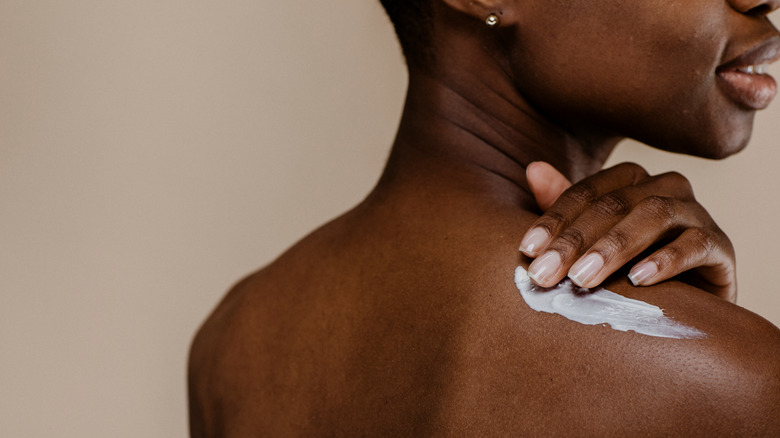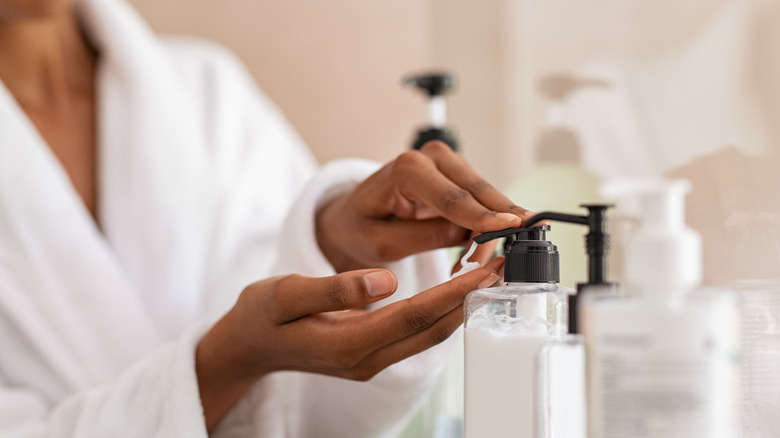What Is Kojic Acid And How Does It Work?
When you're just starting with skincare, it can be pretty taxing to navigate the best products and their ingredients. While learning on the go, you'll discover TikTok's well-loved bikini line ingredient — glycolic acid. You'll also find that there's usually lactic acid in your exfoliators and salicylic acid in many acne treatments worth their salt. On other products, you'll probably see ingredients like hyaluronic acid and ferulic acid, which improve overall skin appearance. The point is there are a lot of elements in skincare, specifically acids, and it can take a lot of Google searches to know them all. One of these acids is kojic acid, which can be found in pretty much any depigmenting and skin-brightening agent you see on the aisles at CVS, Ulta, or whatever beauty supply in your area. If you've ever wondered what this ingredient is, we've got you covered.
According to Get Healthy Skin, kojic acid is a skincare ingredient derived from several types of fungi or mushrooms, including aspergillus oryzae, a fungus used in the fermentation of rice, soybeans, and sweet potatoes. Although kojic acid has had its fair share of controversy as a lightening agent, its use is prevalent among people of color because of its ability to help treat hyperpigmentation or discoloration of the skin, eventually matching the darker patches to the rest of the skin. Now that you know what kojic acid is, here's how it works.
How does kojic acid work, and what are the benefits?
Let's jump into the science of kojic acid. According to Be Beautiful, kojic acid is a tyrosinase inhibitor. Being an inhibitor means it blocks tyrosinase from acting on tyrosine, an amino acid. This is important in treating hyperpigmentation, as the conversion of tyrosine is essential in the multistep process of melanin production. Thus, kojic acid blocks melanin production and cancels further pigmentation. By blocking melanin production, it has been found to work wonders for people dealing with melasma, age spots, and scarring (per WebMD). Melasma, according to the American Academy of Dermatology Association, is a condition that causes dark patches to appear on your skin. As for age spots, they arise mainly from prolonged sun exposure. Kojic acid is excellent for these skin conditions, as it blocks further melanin production, allowing your patches and spots to match the rest of your skin tone.
In addition to reducing melanin production, kojic acid has antifungal and antimicrobial properties (per Healthline). When added to certain products, it can improve the effectiveness of antifungal preparations and can be used to treat skin infections like candidiasis and ringworm. Now that you know what benefits lie with the ingredient's use, here's how to use it in your skin and body care routine, and some precautions you need to take.
How do I incorporate kojic acid into my routine?
You can use kojic acid in soap, powder, lotion, or serum form, all with different application modes and precautions. If you prefer to use soaps or body washes with kojic acid in them, SkinKraft says to ensure you rinse off soon after application. For this, we recommend the Urban Skin Rx Even Tone Cleansing Bar, which has a rating of 4.2 stars at Ulta Beauty. And if you're into lotions or serums like the Topicals Faded Brightening and Clearing Serum, massage well into your skin.
Like other skincare ingredients, you must take precautions while using kojic acid. One of them, as SkinKraft advises, is to avoid using it on broken or damaged skin to prevent further irritation. Kojic acid is also known to sensitize the skin to the sun, so wear a good amount of sunscreen on exposed body parts while wearing sun-protective clothing to avoid further melanin production and sunburns. As Urban Skin Rx explains, it's better to incorporate the ingredient into your routine by using it once in a while and then working your way up to more frequent applications. Starting slow is even more advisable in people with sensitive skin – Green Herbology says to use once the product just once a week. With kojic acid, it's essential to start slow and be patient.


